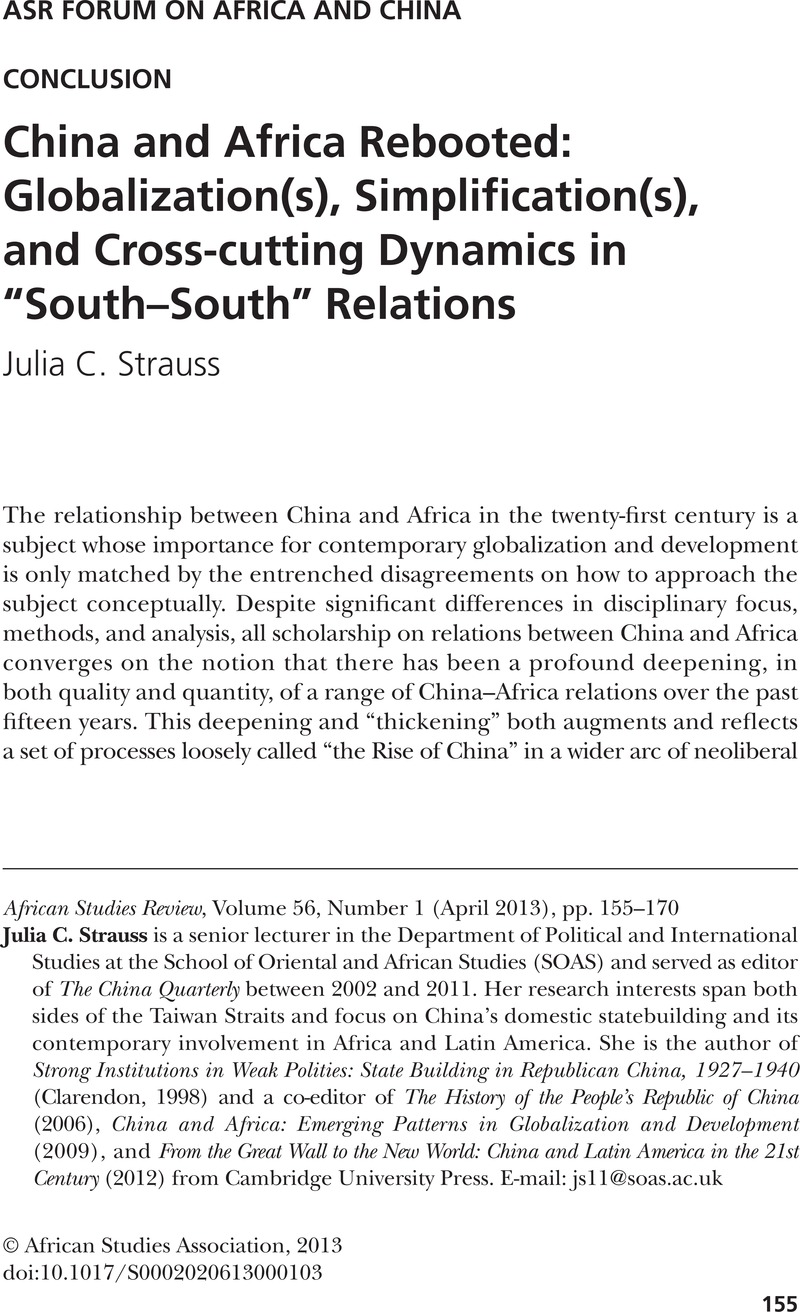No CrossRef data available.
Article contents
China and Africa Rebooted: Globalization(s), Simplification(s), and Cross-cutting Dynamics in “South–South” Relations
Published online by Cambridge University Press: 20 May 2013
Abstract
An abstract is not available for this content so a preview has been provided. Please use the Get access link above for information on how to access this content.

- Type
- ASR FORUM ON AFRICA AND CHINA
- Information
- Copyright
- Copyright © African Studies Association 2013
References
African Development Bank Group. 2010. “Chinese Trade and Investment Activities in Africa.” Policy Brief. Volume 1(4), July 29. www.afdb.org/fileadmin/uploads/afdb/Documents/Publications/Chinese%20Trade%20%20Investment%20Activities%20in%20Africa%2020Aug.pdf.Google Scholar
Blecher, Marc. 2002. “Hegemony and Workers’ Politics in China.” The China Quarterly 170 (June ): 283–303.CrossRefGoogle Scholar
Lee, Ching-Kwan. “Raw Encounters: Chinese Managers, African Workers and the Politics of Casualization in Africa’s Chinese Enclaves.” In China and Africa: Emerging Patterns in Globalization and Development, edited by Strauss, Julia C. and Saavedra, Martha, 97–116. Cambridge: Cambridge University Press.Google Scholar
O’Brien, Cruise, Donal, B. 2003. “Supping with the Devil: The Mouride Brotherhood, 1973–1988.” In Symbolic Confrontations: Muslims Imagining the State in Africa, edited by Cruise O’Brien, Donal B., 31–48. London: Hurst.CrossRefGoogle Scholar
Peng, Cui. 2011. “China Now Africa’s Largest Trade Partner.” China Daily, November 18. http://english.people.com.cn/90778/7649195.html.Google Scholar
Esteban, Mario. 2009. “The Chinese Amigo: Implications for the Development of Equatorial Guinea.” In China and Africa: Emerging Patterns in Globalization and Development, edited by Strauss, Julia C. and Saavedra, Martha, 117–35. Cambridge: Cambridge University Press.Google Scholar
Forum on China–African Cooperation (FOCAC). 2009. “Declaration of Sharm El Sheikh of the Forum on China-Africa Cooperation, ” November 12. www.focac.org/eng/ltda/dsjbzjhy/hywj/t626388.htm.Google Scholar
Haas, Peter. 1992. “Introduction: Epistemic Communities and International Policy Coordination.” International Organization 46 (1): 1–35.CrossRefGoogle Scholar
Hearn, Adrian. 2012. “Harnessing the Dragon: Overseas Chinese Entrepreneurs in Mexico and Cuba.” The China Quarterly 209: 111–33.CrossRefGoogle Scholar
Mawdsley, Emma. 2008. “Fu Manchu versus Dr Livingstone in the Dark Continent? Representing China, Africa and the West in British Broadsheet Newspapers.” Political Geography 27 (5): 509–29.CrossRefGoogle Scholar
Pew Research Center. 2007. “47-Nation Pew Global Attitudes Survey.” June 27. http://pewglobal.org/reports/pdf/256.pdf.Google Scholar
Pew Research Center. 2010. “Obama More Popular Abroad Than at Home, Global Image of U.S. Continues to Benefit.” Pew Research Global Attitudes Project, “Chapter 5: Views of China.”http://www.pewglobal.org/2010/06/17/chapter-5-views-of-china/.Google Scholar
Sautman, Barry, and Hairong, Yan. 2009. “African Perspectives on China–Africa Links.” In China and Africa: Emerging Patterns in Globalization and Development, edited by Strauss, Julia C. and Saavedra, Martha, 178–209. Cambridge: Cambridge University Press.Google Scholar
Wang Mai Tian, Shou. 2011. “The West’s Neo-colonialism in Africa Unmasked.” July 7. www.focac.org/eng/jlydh/mtsy/t837629.htm.Google Scholar
Strauss, Julia C. 2009. “The Past in the Present: Historical and Rhetorical Lineages in China’s Relations with Africa.” In China and Africa: Emerging Patterns in Globalization and Development, edited by Strauss, Julia C. and Saavedra, Martha, 240–43. Cambridge: Cambridge University Press.Google Scholar
Surender, Rebecca. 2013 (forthcoming). “Social Policy in the Context of New Global Actors: How Far Is China’s Developmental Model in Africa Impacting Traditional Donors?” Global Social Policy 13 (3).Google Scholar
Tang, Xiaoyang. 2010. “Bulldozer or Locomotive? The Impact of Chinese Enterprises on the Local Employment Market in Angola.” Journal of Asian and African Studies 45 (3): 350–68.CrossRefGoogle Scholar


